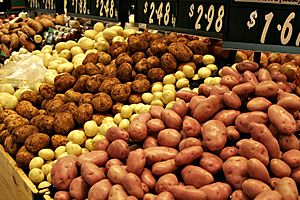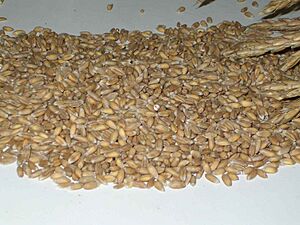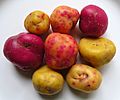Staple food facts for kids



A staple food is a food item that people eat very often. It can be stored easily and eaten throughout the year. Different kinds of staple foods are used in different parts of the world. These foods are the main part of what people eat every day.
For example, potatoes and rice are common staple foods. However, bread is usually not considered a staple food itself. This is because bread is made from other ingredients and cannot be stored for a very long time. But the wheat used to make bread is a staple food because it can be stored.
Staple foods are usually cheap or easy to find. They give us important nutrients that our bodies need to stay healthy and strong. These nutrients include carbohydrates for energy, proteins for building muscles, fats, minerals, and vitamins.
Long ago, when people first started farming, they chose foods that could be stored for a long time without going bad. These foods were very important because they provided food during times when fresh food was scarce. This could be during dry seasons or cold winters. When there was plenty of food, people could eat a wider variety of things.
Foods like fruit are not staples because they only grow at certain times of the year. Meat is also not a staple because it might not always be available or can be expensive. Some green vegetables might be staples in certain places, but not everywhere. Foods that need special storage, like a refrigerator, are also not staple foods.
Common Staple Foods Around the World
Many different foods serve as staples for people across the globe. These foods provide the main energy and nutrients for billions of people.
Here are some examples of important staple foods:
- Maize (also known as corn)
- Rice
- Wheat
- Potatoes
- Cassava
- Soybeans
- Sweet potatos
- Yams
- Sorghum
- Plantains
- Barley
- Lentils
Pictures of Staple Foods
-
Sorghum seeds and popped sorghum.
-
Amaranth (left) and common wheat berries.
-
Millet grains.
-
Colored quinoa.
-
Cassava roots.
-
A tasty Sweet potato salad.
-
Ulluco tubers.
-
Oca tubers.
-
Taro roots.
More Images
See also
 In Spanish: Alimento básico para niños
In Spanish: Alimento básico para niños



















